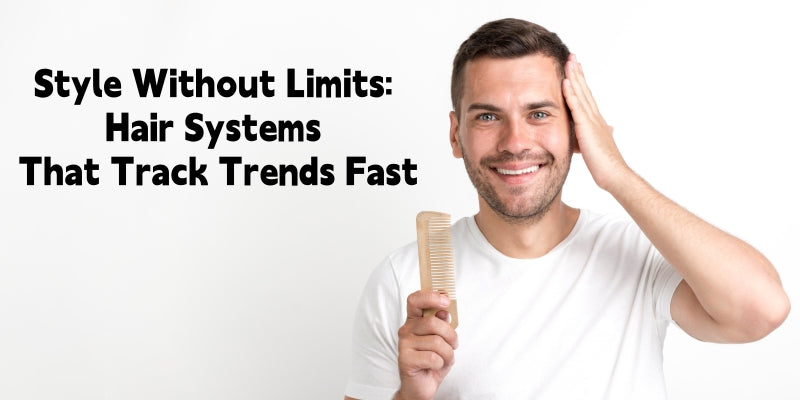
Style Without Limits: How Hair Systems Adapt to Fashion Trends Instantly
Style Without Limits: How Hair Systems Adapt to Fashion Trends Instantly
Trends are a moving target: one minute it’s a soft fringe with streetwear layers; the next it’s a glossy side part under a double-breasted suit. A surgical hairline can’t pivot on a dime—but a modern hair system can. With the right base, density, and cut strategy, you can evolve your look as quickly as your feed.
The Trend Engine: Why Hair Systems Win
Three reasons hair systems outpace surgical routes: speed (changes in a single appointment), range (from crop fades to long waves), and reversibility (try it, adjust it, redo it). The ultra-thin skin front gives cinematic realism for slick looks, while lace fronts excel at airy texture and movement.
Bases & Densities That Enable Fast Restyles
- Ultra-thin skin front: Perfect for clean parts, wet looks, and precise edges
- Lace front: Best for messy texture, lifted quiffs, and natural cowlicks
- Hybrid designs: Mix lace and skin to combine realism, hold, and breathability
Density map: Keep front 80–100% for lift and realism; mid-zone 100–110% for shape; crown 90–100% for believable scalp show-through. This blueprint supports both slick and textured trends.
Cut Playbook: From Fades to Fringes
Work with a stylist who understands hair systems and clipper guards. Here’s a trend-forward roster you can rotate through a single year:
- Low Taper Fade + Side Part: A boardroom staple; skin front shines for a crisp part and tight edge work.
- Textured Crop: Lace front breathes and moves; pair with matte paste for a lived-in, European street look.
- Modern Quiff: Hybrid base for structure at the front and airflow at the top; blow-dry with a vent brush.
- Soft Fringe: Lower density at the hairline and point-cut ends keep the fringe feathered, not blocky.
- Medium Waves: 4–6 inches on top with subtle layering; use a heat protectant and 1–2 light bends with a dryer.
Ask for scissor-over-comb around the perimeter for seamless blending with your sides. Keep the front contour slightly irregular for realism under harsh lighting.
Color Updates: Subtle to Statement
Because systems are replaceable, color exploration is low-risk. Consider:
- Micro highlights (babylights): Add dimension for textured cuts
- Ash or cool tones: Reduce warmth under studio lights
- Seasonal shifts: Warmer caramel in summer; deeper espresso for autumn
- Statement streak: A narrow, high-contrast panel for editorial impact (keep density moderate to avoid helmet effect)
When coloring human-hair systems, use pro-level, low-ammonia formulas and treat mid-lengths only. Always deep-condition post-color to protect the cuticle.
Seasonal Lookbook
Spring: Reset & Texture
Transition to a textured crop with a lace front for airflow. Light pomade or cream maintains separation without shine. Consider soft highlights to mirror brighter wardrobe palettes.
Summer: Heat-Proof Styles
Keep it short and breathable. Hybrid bases prevent lift in humidity while maintaining a natural hairline for poolside photos. Use alcohol-free sea-salt “alternatives” for beach texture without dehydrating the hair.
Autumn: Tailored & Polished
As tailoring returns, shift to a side part or a subdued quiff. Ultra-thin skin fronts create razor-clean parts that read expensive in evening settings.
Winter: Volume & Fringe
Layered lengths and soft fringes pair with knitwear and outerwear. A touch of heat styling adds structure under beanies and hoods without collapsing the silhouette.
Streetwear to Formal in 5 Minutes
Two-product strategy: a matte paste for texture and a medium-hold cream for polish. For day-night transitions, mist lightly with water, blow-dry the front for 45 seconds, switch products, and define the part with a tail comb.
Care, Longevity & Heat Styling
- Heat discipline: Always apply heat protectant; keep dryers on medium; avoid daily hot tools
- Wash cadence: 2–3×/week with sulfate-free formulas; condition mid-lengths only
- Rebonds: Every 7–14 days depending on activity; clean edges thoroughly to preserve lace/skin
- Brush choice: Vent brush for volume; soft boar mix for polish; never yank at the base
A two-unit rotation lets you color-experiment on one while preserving a classic, office-ready option on the other—your personal “trend lab.”
FAQ
Can I switch from a crop to waves in one unit?
Yes—if you start with 4–6 inches on top and a balanced density map. Your stylist can re-shape across appointments.
Will frequent restyling damage the unit?
Use heat sparingly, products without drying alcohols, and cleanse build-up regularly. Most users rotate 2–3 units to extend life.
How do I keep the hairline natural across styles?
Graduate density at the front, keep the contour slightly imperfect, and use liquid adhesive sparingly for a skin-like edge.
Recommended Products
Lace-Front Hybrid System
Best-in-class versatility for textured cuts and quick part changes.
Shop NowTrend Today, New Trend Tomorrow
Switch cuts, colors, and finishes without waiting months. That’s the power of hair systems.
Explore Men’s Hair Systems







